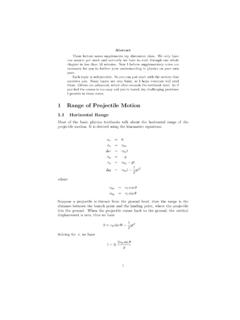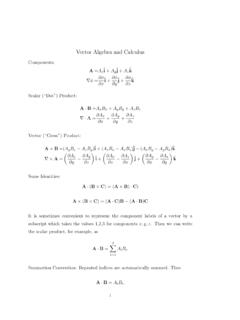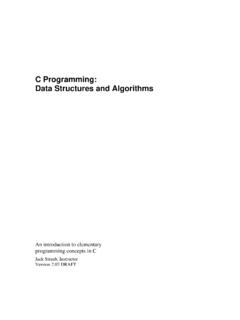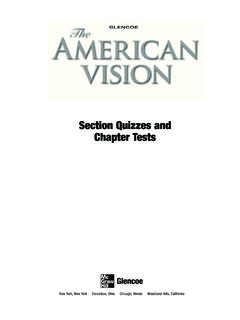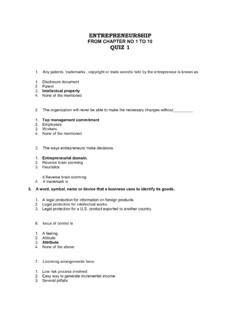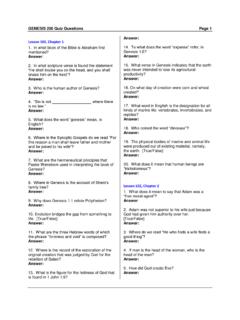Transcription of Chapter 21: RLC Circuits
1 PHY2054: Chapter 211 Chapter 21: RLC CircuitsPHY2054: Chapter 212 Voltage and Current in RLC Circuits AC emf source: driving frequency f If circuit contains only R + emf source, current is simple If L and/or C present, current is notin phase with emf Z, shown later()sinmmmiItIZ = =sinmt =2f =()()sincurrent amplitudemmmiI tIRR ===PHY2054: Chapter 213AC Source and Resistor Only Driving voltage is Relation of current and voltage Current is in phasewith voltage ( = 0)i R~sinmmmiIt IR ==sinmt =/iR =PHY2054: Chapter 214AC Source and Capacitor Only Voltage is Differentiate to find current Rewrite using phase (check this!) Relation of current and voltage Capacitive reactance : Current leads voltage by 90 sinmqCt =i C~/cosCidqdt CVt ==sinCmqvtC ==()sin90 CiCVt =+ ()sin90mmmCiItIX =+ =1/CXC =()1/CXC =PHY2054: Chapter 215AC Source and Inductor Only Voltage is Integrate di/dt to find current: Rewrite using phase (check this!)
2 Relation of current and voltage Inductive reactance : Current lags voltage by 90 ()//sinmdi dtLt =i L~()/cosmiLt = /sinLmvLdi dtt ==()()/sin 90miLt = ()sin90mmmLiItIX = =LXL =()LXL =PHY2054: Chapter 216 General Solution for RLC Circuit We assumesteady state solution of form Imis current amplitude is phase by which current lags the driving EMF Must determine Imand Plug in solution: differentiate & integrate sin( t- )()sinmiIt = () ()()cossincossinmmmmIILt IRtttC + =sinmdiqLRitdtC ++=()sinmiIt = ()cosmdiItdt = ()cosmIqt = SubstitutePHY2054: Chapter 217 General Solution for RLC Circuit (2) Expand sin & cos expressions Collect sin t&cos tterms separately These equations can be solved for Imand (next slide)()()1/cossin01/sincosmmmLCRIL CIR = +=()()sinsincoscossincoscoscossinsintt ttt t = =+High school trig!cos ttermssin tterms() ()()cossincossinmmmmIILt IRtttC + =PHY2054: Chapter 218 Solve for and Im R, XL, XCand Z have dimensions of resistance This is where , XL, XCand Z come from!
3 General Solution for RLC Circuit (3)1/tanLCXXLCRR = mmIZ =()22 LCZRXX=+ LXL =1/CXC =Inductive reactance Capacitive reactance Total impedance PHY2054: Chapter 219AC Source and RLC CircuitstanmmLCIZXXR = =Phase angleMaximum current = angle that current lags applied voltage()21/LCXLfXC ===Inductive reactanceCapacitive reactance()22 LCZRXX=+ Total impedancePHY2054: Chapter 2110 What is Reactance?Think of it as a frequency-dependent resistanceShrinks with increasing 1 CXC =LXL =("")RXR=Grows with increasing Independent of PHY2054: Chapter 2111 Pictorial Understanding of ReactancetanLCXXR =()22 LCZRXX=+ cosRZ =PHY2054: Chapter 2112 Summary of Circuit Elements, Impedance, Phase Angles()22 LCZRXX=+ tanLCXXR =PHY2054: Chapter 2113 quiz Three identical EMF sources are hooked to a single circuit element, a resistor, a capacitor, or an inductor. The current amplitude is then measured as a function of frequency.
4 Which one of the following curves corresponds to an inductive circuit? (1) a (2) b (3) c (4) Can t tell without more infofImaxacb()maxmax2/LLXLfIX ===For inductor, higher frequency gives higherreactance, therefore lower currentPHY2054: Chapter 2114 RLC Example 1 Below are shown the driving emf and current vs time of an RLC circuit. We can conclude the following Current leads the driving emf ( <0) Circuit is capacitive (XC> XL) ItPHY2054: Chapter 2115 RLC Example 2 R = 200 , C = 15 F, L = 230mH, max= 36v, f= 60 Hz 260 = = ()61/ 260 15 10177CX = = () 177219Z=+ = maxmax/36 / 219 AIZ ===XC> XLCapacitive == Current leads emf(as expected)() =+ PHY2054: Chapter 2116 Resonance Consider impedance vs frequency Z is minimum when This is resonance! At resonance Impedance = Z is minimum Current amplitude = Imis maximum()()22221/LCZRXXR L C =+ =+ 1/LC =01/LC ==PHY2054: Chapter 2117 Imaxvs Frequency and Resonance Circuit parameters: C = F, L = 4mH, max= 10v f0= 1 / 2 (LC)1/2= 1590 Hz Plot Imaxvs fR= 5 R= 10 R= 20 ImaxResonance0ff=f / f0()22max10 /1/IRLC =+ PHY2054: Chapter 2118 Power in AC Circuits Instantaneous power emitted by circuit: P =i2R More useful to calculate power averaged over a cycle Use <.
5 > to indicate average over a cycle Define RMS quantities to avoid factors in AC Circuits House current Vrms= 110V Vpeak= 156V()22sinmdPIRt = ()22212sinmd mPIRtIR = =rms2mII=rms2m =2avermsPIR=Instantaneous power oscillatesPHY2054: Chapter 2119 Power in AC Circuits Power formula Rewrite using cos is the power factor To maximize power delivered to circuit make close to zero Max power delivered to load happens at resonance , too much inductive reactance (XL) can be cancelled by increasing XC( , Circuits with large motors)2avermsPIR=rmsavermsrms rmscosZPIRI ==averms rmscosPI =cosRZ =rmsrmsIZ =rmsmax/2II=RLCXX Z PHY2054: Chapter 2120 Power Example 1 R = 200 , XC= 150 , XL= 80 , rms= 120v, f= 60 Hz ()2220080 + = 180 == =averms rmscos120 == =rmsrms/120 / AIZ == = =Current leads emfCapacitive circuitSamePHY2054: Chapter 2121 Power Example 1 (cont) R = 200 , XC= 150 , XL= 80 , rms= 120v, f= 60 Hz How much capacitance must be added to maximize the power in the circuit (and thus bring it into resonance)?
6 Want XC= XLto minimize Z, so must decrease XC So we must add F capacitance to maximize power1501/ FCXfCC = == FCLXXC== =PHY2054: Chapter 2122 Power vs Frequency and Resonance Circuit parameters: C = F, L = 4mH, max= 10v f0= 1 / 2 (LC)1/2= 1590 Hz Plot Pavevs f for different R valuesR= 5 R= 10 R= 20 0ff=PaveR= 2 Resonancef / f0 PHY2054: Chapter 2123 Resonance Tuner is Based on ResonanceVary C to set resonance frequency to (ugh!)Circuit response Q = 500 Tune for f = MHzOther radio response is lessPHY2054: Chapter 2124 quiz A generator produces current at a frequency of 60 Hz with peak voltage and current amplitudes of 100V and 10A, respectively. What is the average power produced if they are in phase? (1) 1000 W (2) 707 W (3) 1414 W (4) 500 W (5) 250 W1avepeak peakrms rms2 PII ==PHY2054: Chapter 2125 quiz The figure shows the current and emf of a series RLC circuit. To increase the rate at which power is delivered to the resistive load, which option should be taken?
7 (1) Increase R (2) Decrease L (3) Increase L (4) Increase CCurrent lags applied emf ( > 0), thus circuit is inductive. Either(1) Reduce XLby decreasing L or(2) Cancel XLby increasing XC(decrease C).tanLCXXR =PHY2054: Chapter 2126 Example: LR Circuit Variable frequency EMF source with m=6V connected to a resistor and inductor. R=80 and L=40mH. At what frequency f does VR= VL? At that frequency, what is phase angle ? What is the current amplitude and RMS value?20002000 / 2318 HzLXLRf == ===tan/145 LXR == = 22maxmax/ 80806 /113 AI =+==rmsmax/ AII==() = PHY2054: Chapter 2127 Transformers Purpose: change alternating (AC) voltage to a bigger (or smaller) valueppBVNt = BssVNt = Input AC voltagein the primary turns produces a fluxssppNVVN=Changing flux in secondary turnsinduces an emfPHY2054: Chapter 2128 Transformers Nothing comes for free, however! Increase in voltage comes at the cost of current.
8 Output power cannot exceed input power! power in = power out (Losses usually account for 10-20%)ppssiViV=ppsps sVNiiVN==PHY2054: Chapter 2129 Transformers: Sample Problem A transformer has 330 primary turns and 1240 secondary turns. The input voltage is 120 V and the output current is A. What is the output voltage and input current?1240120451V330ssppNVVN == = Step-up transformerppssiViV= A120spspViiV == = PHY2054: Chapter 2130 This is how first experiment by Faraday was done He only got a deflection of the galvanometer when the switch is opened or closed Steady current does notmake induced : Chapter 2131 MicrophoneTape recorderApplicationsPHY2054: Chapter 2132 ConcepTest: Power lines At large distances, the resistance of power lines becomes significant. To transmit maximum power, is it better to transmit (high V, low i) or (high i, low V)? (1) high V, low i (2) low V, high i (3) makes no differencePower loss is i2 RPHY2054: Chapter 2133 Electric Power Transmissioni2R: 20x smaller current 400x smaller power loss



